|
Arcangelo Raffaello Borgo San Frediano |
San Carlo dei Barnabiti |
|
 History Founded in 1531, on the site of the earlier Hospital of Santa Lucia belonging to the confraternity of the Bigallo (1428-1530), by the Benedictine nuns from the monastery of Sant'Anna in Verzaia, whose convent had been destroyed during the siege of 1529. In 1538 it passed to the Franciscan Tertiaries. With suppression in 1748 the building was used as a hospice for mendicants and various other uses followed, involving substantial alterations. After 1845 the monastery became a tobacco factory and then a barracks. It then became the sculpture studio of Lorenzo Bartolini who, after his death, passed the building on to his protégé Pasquale Romanelli who worked here from 1851 to 1887. There is a plaque to his memory near the main entrance. The building remains in the Romanelli family and is today used as a sculpture showroom. Over the door there is a marble bas-relief by one of the Cennini of The Archangel Raphael with Tobias. |
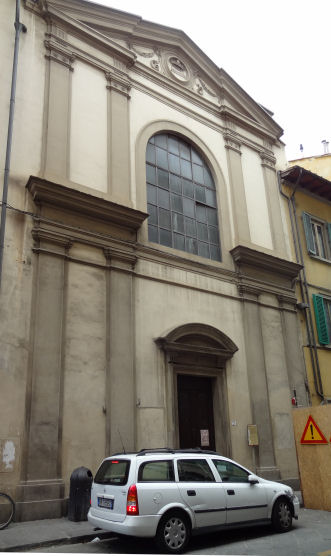 History Built in 1636 by Gherardo Silvani for the Barnabites, replacing the order's oratory on the site. The order thrived in the early 18th century, hence the ceiling fresco by Sigismondo Betti of The Glory of the Virgin with Saint Paul and Saint Carlo Borromeo from 1721, the architectural work by Bernardino Ciurini in 1743, the perspective views by Domenico Stagi of 1757-58, and more painting (in the dome and spandrels) by Giuseppe Zocchi in 1747. Suppressed in 1783, the church passed into private hands, until 1838 when it was acquired by the Scalopi Fathers, who kept it until 1866. Since then it has been used as a school, a gymnasium, and for art exhibitions and the like. Recent work (2026) means the façade now looks like new and the big recent multi-light window has been replaced with an even newer one (see left). |
|
|
San Bartolomeo a Monte
Oliveto Via del Monte Oliveto |
||
|
History A monastery here was founded in 1334 by monks from the Olivetan abbey of Monte Oliveto Maggiore. It was enlarged in 1377 on land donated by Bartolomeo Capponi and was rebuilt in its current form in 1454. Further work in 1472, 1725 and 1955. Around 1553 Cosimo I began building fortifications on Mount Oliveto and the monks moved to the Church of San Michele Berteldi in Florence. They returned here in 1592. The Olivetans left in 1866, and the monastery became a military hospital for infectious diseases, which closed in 1997. The complex crumbled into its current ruinous state and is undergoing rebuilding. Interior A single nave, the church has 16th century frescoes and several altarpieces, by Sodoma (a Last Supper taken from the refectory, with its sinopia), Bernardino Pocetti, Domenico Passignano, Simone Pignoni and Fabrizio Boschi. Lost art The famous and fine Annunciation by Leonardo da Vinci (see below) was painted for this church, but went to the Uffizi in the 19th century. It's his first existing painting. Santi di Tito's Entry of Christ into Jerusalem, painted for the high altar here, is now in the Accademia, as is a Lorenzo Monaco Triptych, and a 1497 Resurrection of Christ by Raffaellino del Garbo, formerly in the Capponi Chapel here. 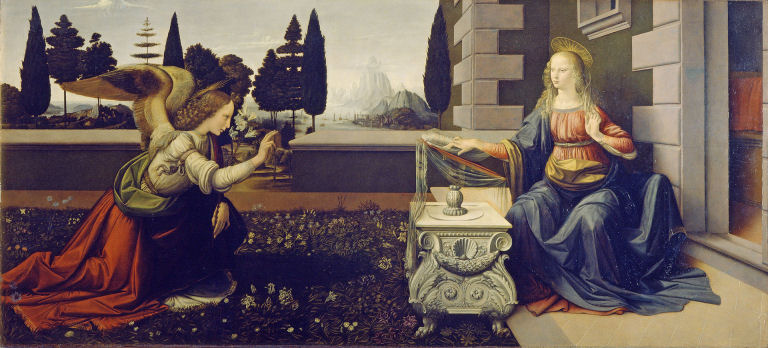 Opening times Monday - Friday 9.30-12.00, 3.30–6.00 Saturday Closed Sunday Closed |
|
|
|
San Felice in Piazza Piazza di San Felice |
||
Interior
Lost art
Feast day performances |
|
|
|
San Francesco di Paola Piazza San Francesco di Paola |
||
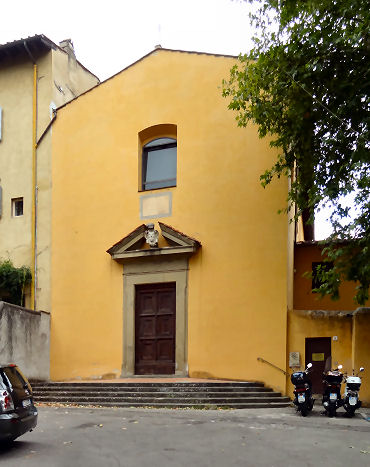 History Built for Franciscan Minim friars (the order founded by Saint Francis of Paola, which was devoted to humility and veganism) previously established at the church of San Giuseppe. The complex was built on farmland provided by Alessandro di Camillo Strozzi, with work starting in 1589. The architect Gherardo Silvani was involved from 1638 to the church's completion in 1643 although his contributions aren't documented. Restoration in the mid-18th century, including decoration and work on the roof, and 1996-2005.  The monastery was suppressed in 1782 by Grand Duke Pietro Leopoldo, and turned into a villa (in 1873?) by Senator John Federighi, with the church becoming a private chapel, as commemorated by a marble slab over the door of the church. The neoclassical sculptor Adolf von Hildebrand later lived here creating, in the 1870s, a celebrated salon whose visitors included Liszt, Wagner, Gladstone, and Henry James. The church has since been reconsecrated and is now used as a parish church. The monastery is now private apartments owned by the heirs of the British historian Harry Brewster, who married one of Adolf von Hildebrand's daughters. Art highlights Here since 1785 has been the detached fresco fragment of The Madonna del Parto by Taddeo Gaddi (c. 1355) (see left) taken from the demolished church of San Pier Maggiore. But it is said to have originally come from San Donato a Scopeto, destroyed in 1529, the same church which supplied the Romanesque portico now on the façade of San Jacopo sopr'Arno and for which Leonardo was commissioned to paint his early and unfinished Adoration of the Magi, now in the Uffizi. It was discovered in 1964 and restored in 1966. Also a 15th century wooden crucifix, an Annunciation attributed to Giovan Battista Vanni, a 1602 Portrait of San Francesco di Paola, six canvases of Stories of Saint Francis of Paola by Ignazio Hugford, and two works by Giuseppe Moriani of 1716. In the garden there is a statue of Saint Francis of Paola by Giuseppe Piamontini (1695). Lost art The tomb of Bishop Jerome Benozzo Federighi by Luca della Robbia originally here has since been moved to San Pancrazio (in 1809) and to Santa Trinita in 1895, where it remains. |
||
|
San
Francesco di Sales |
||
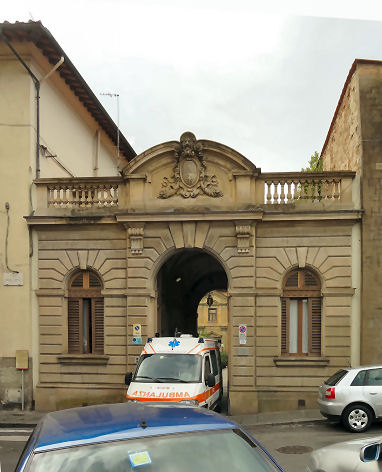 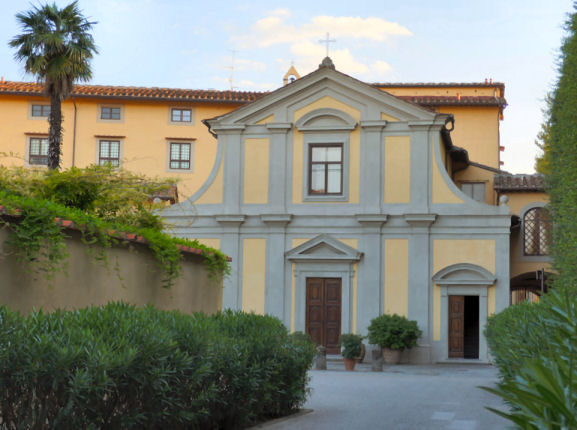 History The church, along with the girls' boarding-school of San Francesco di Sales, known as the Conventino, were built in 1700 to a design by Anton Maria Ferri and financed by the Da Verrazzano family. The church and school were built on part of the site of the former Camaldolese monastery of San Salvatore, of which some buildings still remain.
Interior |
||
|
San Frediano in Cestello Lungarno Soderini |
||
|
History 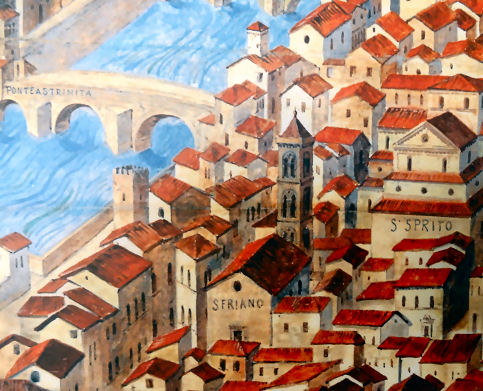 The original church is said to have been built to celebrate a miracle performed by the 6th-century Irish saint, and Bishop of Lucca, Fridianus (Frediano). The Cistercians in residence, from whom the church derives its name, were moved to Santa Maria Maddalena in 1514 to make way for Carmelite nuns, with the patronage of the Soderini family. The Carmelite convent was called Santa Maria degli Angeli. By the time Paolo Antonio Soderini was exiled, in the mid-16th century, when the Grand Duke took over as patron, the area had become more densely populated. The Cistercians returned in 1628 when Cardinal Francesco Barberini moved the Carmelite nuns to Santa Maria Maddalena. He did this because two of his nieces, Innocenza and Grazia, were nuns here and it wasn't the nicest of areas. The Cistercians instituted rebuilding, to designs by Silvani executed by Antonio Cerutti, from 1680-1689. It was at this time that the church was moved and turned to face North, having been previously west-facing, as seen in the Catena map of 1471 (see above). The cupola and campanile were built in 1698 by Antonio Ferri, who also had a hand in Palazzo Corsini over the Arno. Following Grand Duke Leopold's suppressions of 1808 the Cistercians left and the building became a parish church. Interior Airy and two-tone white and grey, with the grey being very bluish. Aisleless, it's very 18th-century inside and quite low-key Baroque, with three deep interconnected open chapels down each side of the nave. All of them are finely frescoed in the domes, lunettes and pendentives by six Florentine painters of the late-17th and early-18th centuries, including Gabbiani, Bonechi and Dandini. The left hand ones all have lanterns in their domes, but the right hand ones rely on light from the clerestories. The transept is bare of decoration with no altars, just two pairs of wooden confessionals at each end with paintings above - the Crucifixion and the Virgin in Glory mentioned below. The impressive painting of the the Virgin in Glory in the central dome (see photo below) is by Antonio Domenico Gabbiani (1702–1718). The Four Virtues in the pendentives are by Matteo Bonechi. There's a polychrome wooden Virgin and Child by a follower of Nino Pisano, the son of Andrea, of c. 1350. Crucifixion with Saints and Martyrdom of St. Lawrence by Jacopo del Sellaio. Virgin in Glory with Saints by Francesco Curradi. Frescoes of Scenes from the life of the founder of the Cistercian order (1688–1689) by Pier Dandini. The refectory has a Last Supper by Bernardino Poccetti. In the cloisters there's a statue of Santa Maria Maddalena de' Pazzi (1726) by Antonio Montauti and St Bernard of Clairvaux defeats the devil (1702) by Giuseppe Piamontini. Lost art Jacopo del Sellaio painted a Crucifixion altarpiece in 1483 for the chapel of the Compagnia delle Brucciata in this church (see below right). It was unfinished at the artist's death and was completed by his son Arcangelo. It is a non-narrative treatment of the subject, featuring Saints Frediano and Jerome kneeling in the foreground, with small narrative scenes, including the suicide of Judas and the remorseful Peter, in the background. Around 1517/18 a terracotta lunette of the Resurrected Christ and a frame (now also lost) were commissioned from Andrea della Robbia. The altarpiece ended up in the Kaiser Friedrich Museum in Berlin and was destroyed (or stolen) in the fires and looting in the Friedrichshain flak tower (flakturm) in May 1945, where paintings from the Berlin collections were being stored to protect them from bombing. 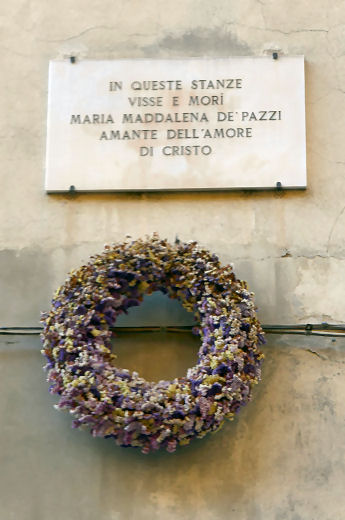 An artist nun Antonia Uccello, the daughter of artist Paolo, was a Carmelite nun here. She was a reputable artist, mentioned as such by Vasari (who described her as a 'daughter who knew how to draw') but none of her work has survived, or can be identified. Her death certificate even described her as a pittoressa. A Pazzi family nun Maria Maddalena de' Pazzi was a Carmelite nun from the Pazzi family who had lived, and died, here before the Carmelites moved to the church which now bears her name. When possessed of the holy spirit, she would speak at such a rate as took eight novices to transcribe her utterances. She was also known to pour boiling wax on her arms and lie naked in thorns. She was canonized in 1669 and is buried at Santa Maria Maddalena dei Pazzi. She is commemorated here by a plaque on he convent wall facing the street (see right). Opening times 9.30-11.30 & 5.00-6.00 |
|
|
|
|
||
|
San Giorgio alla Costa Costa San Giorgio |
||
|
History 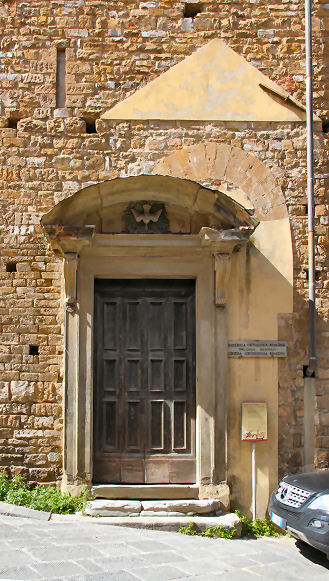 The original church may date from the 10th century. A convent was added and having belonged to the Canons of Sant'Andrea a Mosciano, the Dominicans and the Silvestrines, in 1520 it was rebuilt at the behest of Lucrezia de 'Medici, daughter of Lorenzo the Magnificent, and granted to the Vallombrosan nuns, who dedicated it to the Holy Spirit. Restored in baroque style by Giovanni Battista Faggini in 1705-8. At this time the ceiling painting of The Glory of St George by Alessandro Gherardini was added, and the oval painting on Faggini's high altar, showing The Descent of the Holy Ghost by Anton Domenico Gabbiani. Other altarpieces were by Tommaso Redi, Jacopo Vignali and Passagnano. Suppressed by Napoleon in 1808, between 1926 and 1933 the complex was converted to house the headquarters of the Barracks Vittorio Veneto. The church is currently used by a Romanian Orthodox congregation, but due to structural damage to the roof they have to use the crypt (see photo far below right) through the small entrance doorway to the steep street (see photo right). But I recently read that in 2018, after a closure of 35 years, the roof was repaired and the church reopened. And in November 2021 restoration work on the baroque interior (see below right) and the installation of new lighting was completed. Lost art A very early Giotto - the Madonna of  San Giorgio alla Costa of c.1296 (see right) is
now in the possession of the (never open) Diocesan Museum
at Santo Stefano al Ponte,
but it has recently gone on
display in the Opera del Duomo Museum on temporary loan. It was reattributed to Giotto only in 1939 by German art
critic Robert Oertel - Ghiberti and Vasari had both thought
it by Giotto, though. Richard Offner, who was the one who found it, thought it the work of the Saint Cecilia
Master (an opinion which held sway in the early 20th century) and mentioned documents telling of it working
miracles still in 1801. Opinions are still divided. The painting was cut down on all four sides in the
18th century to fit a baroque altar. It is very red, but the Virgin's
black robe has discoloured drastically from its original blue.
For many years the panel was kept
in Santo Stefano al Ponte where it was damaged on May 27th 1993 in the
mafia car-bombing of the Uffizi. During its restoration a tear was left in the left
corner in memory of the event. In addition, in the catalogue to the recent
exhibition in Milan Giotto, L'Italia, in an essay on this
Madonna, Andrea de Marchi suggests that a Crucifix painted for
this church and mentioned by Ghiberti is the one currently in the Parisian
seminary at Issy-les-Moulineaux. Conservation work may soon reveal
whether this is so.
Another Crucifix, from the last quarter of the 13th century,
by an anonymous Florentine, damaged and now in the Accademia, is also said to
be probably the one seen by Ghiberti and thought by him to be by Giotto. San Giorgio alla Costa of c.1296 (see right) is
now in the possession of the (never open) Diocesan Museum
at Santo Stefano al Ponte,
but it has recently gone on
display in the Opera del Duomo Museum on temporary loan. It was reattributed to Giotto only in 1939 by German art
critic Robert Oertel - Ghiberti and Vasari had both thought
it by Giotto, though. Richard Offner, who was the one who found it, thought it the work of the Saint Cecilia
Master (an opinion which held sway in the early 20th century) and mentioned documents telling of it working
miracles still in 1801. Opinions are still divided. The painting was cut down on all four sides in the
18th century to fit a baroque altar. It is very red, but the Virgin's
black robe has discoloured drastically from its original blue.
For many years the panel was kept
in Santo Stefano al Ponte where it was damaged on May 27th 1993 in the
mafia car-bombing of the Uffizi. During its restoration a tear was left in the left
corner in memory of the event. In addition, in the catalogue to the recent
exhibition in Milan Giotto, L'Italia, in an essay on this
Madonna, Andrea de Marchi suggests that a Crucifix painted for
this church and mentioned by Ghiberti is the one currently in the Parisian
seminary at Issy-les-Moulineaux. Conservation work may soon reveal
whether this is so.
Another Crucifix, from the last quarter of the 13th century,
by an anonymous Florentine, damaged and now in the Accademia, is also said to
be probably the one seen by Ghiberti and thought by him to be by Giotto.Alesso Baldovinetti's early Annunciation, panel, painted c.1457 for the Silvestrine friars here. In the Uffizi since 1868. Neri di Bicci Annunciation, with Saints Jerome and Francis, 1460. Painted at the commission of Bartolommeo Corsellini for this church, now in the Accademia. Two panels showing San Pietro Igneous and San Benedetto, the latter looking very troubled, described as Toscana Scuola are now in the in the Andrea del Sarto Cenacolo Museum at San Salvi. A panel depicting The Virgin and Child with Saints John the Baptist, Sylvester, Martin and Filippo Benizzi, by Agnolo di Donino is now on the high altar in Santa Lucia dei Magnoli down the hill. A detached fresco of half of the Crucifixion with Mary Magdalene of c.1510, and attributed to Raffaelino del Garbo, which is thought to have come from this church, is in the Innocenti Museum. Opening times Opened for Romanian Orthodox services Sundays at 10.30. |
|
|
|
San Girolamo |
||
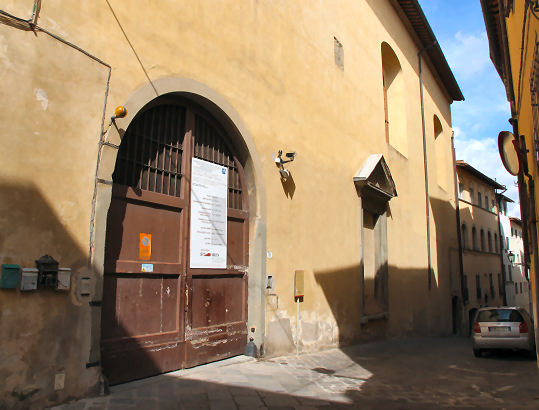 History Built in 1432, the church of the former convent of San Girolamo alla Costa was built in 1432. The complex had been built in the 14th century for the sisters of the Franciscan Third Order, and enlarged in the 15th century, when the tabernacle over the old entrance (later walled up) was painted. It represents The Crucifixion between St Jerome and St Francis and is attributed to Pier Francesco Fiorentino. Rebuilt between 1515 and 1520 with further work in the 17th and 18th century which altered the church considerably. Suppressed in 1808, the convent was reopened in 1816 but was again suppressed in 1866 an put to military uses, with the church becoming the Vittorio Veneto barracks chapel in 1928. Currently (since December 2011) undergoing restoration work.
A daughter of Galileo’s
sister Virginia was a nun here, with the name of Suor Arcangiola. Maria
Virginia, the daughter of his grandson Vincenzo, was also a nun here, with the
name of Suor Maria Olimpia.
|
||
|
San
Giovanni della Calza |
||
|
Lost art
|
|
|
|
San Jacopo sopr'Arno Borgo San Jacopo |
||
|
History Built in the 10th/11th centuries in a Romanesque style. According to Vasari Brunelleschi built a chapel here, the Ridolfi Chapel, the dome of which was a dry run for his famous dome on the Duomo. The chapel was destroyed during major rebuilding in the 18th century following responsibility passing to the Missionary Fathers. From 1542 - 1575 the complex was run by Franciscans. Following damage during the 1966 flood restoration work uncovered original features, including columns belonging to the original Romanesque church. The church is currently used by a Greek Orthodox congregation The façade The Romanesque portico, possibly 11th-century, was brought here from the church of San Donato a Scopeto, a church at the foot of Bellosguardo demolished in 1529 to clear ground before the siege. Interior Baroque and dating from 1709. Nice old columns and spandrels  have been revealed at the sides, which complement the later and more
baroque additions, rather than being covered up by them. Lots of icons
around, the church currently being used by a Greek Orthodox congregation.
During services expect chanting and incense, atmospheric mistiness, and
bell-shaking also.
have been revealed at the sides, which complement the later and more
baroque additions, rather than being covered up by them. Lots of icons
around, the church currently being used by a Greek Orthodox congregation.
During services expect chanting and incense, atmospheric mistiness, and
bell-shaking also.Almost all of the art here dates from the 18th century rebuilding. Works by Pier Dandini (frescoes in the vault depicting Saint James), Niccolò Lapi (Moses) Matteo Bonechi (dome fresco of The Virgin in Glory with Angels) and Agostino Veracini (St. Francis of Assisi). Campanile Designed by Gherardo Silvani in 1660. Lost art Two panels, depicting Saint Catherine of Alexandria and Saint Francis by the Master of the Strauss Madonna from c.1410-15 are said to be from an altarpiece brought here by the Observant Franciscans. They're now in the Accademia. Sogliani's Holy Trinity and Saints, with millions of putti, is in the Andrea del Sarto Cenacolo Museum at San Salvi. Rude locals Because of it's flying buttresses hanging over the river supporting its apse-end (see photo right) this church is popularly known as 'the church with its arse in the Arno'. |
|
|
|
San Leonardo in Arcetri |
||
|
|
||
|
San Miniato al Monte Viale Galileo Galilei |
||
|
San Niccolò sopr'Arno Via di San Niccolò |
||
|
History Originally a Romanesque church founded around 1050, mentioned in a papal bull by Lucius III of March 3rd 1184, the church was largely rebuilt in the late 14th century when it became a parish church to cope with the increased population in the area, funding coming from Bernardo Quaratesi who commissioned from Gentile da Fabriano the Quaratesi Polyptych of 1425, now dismembered and dispersed to various museums (see below). Renovation followed the flood of 1557 and Vasari radically modernised the interior in 1567, installing monumental altars with altarpieces by Il Poppi, Allori and Curradi. Restoration work after the 1966 flood brought to light some fragments of the 15th-century decoration beneath Vasari's additions, such as the Saint Ansanus attributed to Francesco d'Antonio to be found in the chapel at the end of the right-hand side, along with its sinopia opposite. Interior A single nave, tall and plain with a timber roof. Three grey stone and gilded altars down each side of the nave and two flanking the door on the rear facade. Two deep chapels just before the east end, making a crossing of sorts. No labels for any of the art. A fresco showing Saint Ansanus was uncovered here in 1925 and detached (uncovering its sinopia) in 1965. It was initially attributed to Gentile da Fabriano, but later opinion gives it to Francesco di Antonio. It is now in a chapel to the right of the nave. (See photo below right) with its sinopia displayed opposite. It was found behind an altarpiece of God the Father and Saints of Jacopo da Empoli, still on the wall of the nave opposite this chapel. This altarpiece has an ornate oval hole in it through which the face of the saint was visible, it having been mistaken for a face of the Virgin, The left hand chapel has loose tomb slabs propped against its walls. Another detached fresco fragment is on the inner façade, to the left. It depicts Sant'Antonio Abate (see below right) and is now thought to be by the Master of Signa, an anonymous pupil of Bicci di Lorenzo. There is no high altarpiece, but there is an organ loft above. Over the altar in the chapel to the left of the presbytery is a painting of The Preaching of the Baptist (1608) by Jacopo da Empoli, and over the one to the right is The Marriage of the Virgin (1579) by Il Poppi, in a niche meant for a larger painting with an unusually young-looking Joseph. The Michelozzo crucifix is now to be found in a niche over the middle altar on the right side, between two painted cut outs of Mary and John. Jesus has had a cloth tied around his waist, literally. The church has two paintings by Allori, The Martyrdom of Saint Catherine of 1582 over the middle altar on the left, and The Sacrifice of Isaac, signed and dated 1583, on the inner façade on the left. There's also a 12th-century crypt here, the only part of the original church that remains. But photos findable on Wikipedia show it worryingly being used as a restaurant The Sacristy In the sacristy is the reportedly highlight fresco of The Madonna of the Girdle of 1450, probably by Alessio Baldovinetti, in an arched stone shrine attributed to Michelozzo. In here are also said to be found panels by Bicci di Lorenzo and his son Neri di Bicci. I've also read about work here by the Master of Signa, an anonymous pupil of Bicci di Lorenzo, but this may be the fine detached fresco of Sant'Antonio Abate on the inner façade. 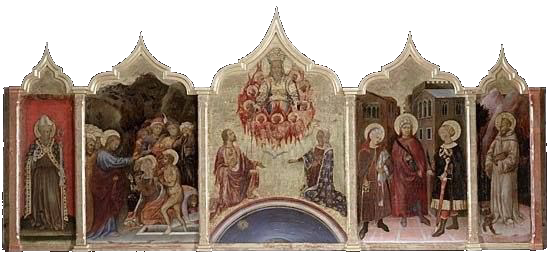 Also five panels from a dossal of 1425 by Gentile da Fabriano, called The Intercession Altarpiece (see above) almost certainly commissioned to commemorate the death of Bernardo di Castello  Quaratesi. Its central panel depicts Christ and the Virgin’s
Intercession to God the Father, the side panels show Saint Louis of
Toulouse, The Raising of Lazarus, Saints Comas and Damian with Saint
Julian, and Saint Bernard. The panels were damaged in the fire here in
1897 and the flood of 1966. They also suffered neglect and bad restoration and
were left in the storerooms of the Pitti Palace. Restoration began in 1995 and
lasted 11 years, with the altarpiece then put on display at the Medici
Palace. It is now back here, it is said. It may have originally come from
San Salvatore al Monte. Quaratesi. Its central panel depicts Christ and the Virgin’s
Intercession to God the Father, the side panels show Saint Louis of
Toulouse, The Raising of Lazarus, Saints Comas and Damian with Saint
Julian, and Saint Bernard. The panels were damaged in the fire here in
1897 and the flood of 1966. They also suffered neglect and bad restoration and
were left in the storerooms of the Pitti Palace. Restoration began in 1995 and
lasted 11 years, with the altarpiece then put on display at the Medici
Palace. It is now back here, it is said. It may have originally come from
San Salvatore al Monte.The campanile Michelangelo hid in a small room at the base the bell-tower from the victorious Medici faction after the siege of Florence in 1530. He had sided with the republican faction. Lost art An Annunciation panel by Masolino of c.1423/24 was the altarpiece of the Guardini chapel on the left side of the tramezzo here. When the tramezzo was demolished during Vasari's modernising it was moved to the altar of the other Guardini family chapel here. It was then moved in 1576 to the sacristy and replaced by a new Annunciation altarpiece by Alessandro Fei. The Masolino panel is now in the Washington National Gallery, in Room 4 next to the predella panel from the Quartesi Altarpiece by Gentile da Fabriano mentioned below.
|
|
|
|
San Pier Gattolino |
||
 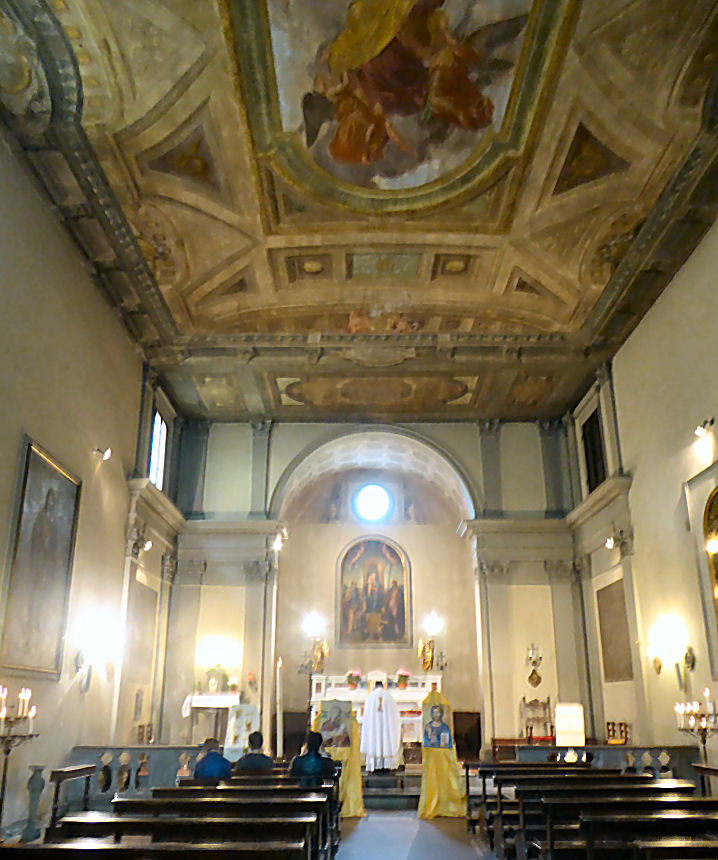 History Documented from 1050, the old church of 'San Pietro Gattuario' was demolished in 1552 to make way for Cosimo I's fortifications. Rebuilt by a workman nicknamed Umido, who collected the necessary funds and materials, it was known as the church of Serumido. (The street beside the church is called the Via Ser Umido.) This rebuilding, in the manner of Santi di Tito was completed around 1571. The church became the favourite of Medici servants. St Philip Neri was born in the parish and was baptised here. Domenico Veneziano was buried here on the 15th of May 1561. The painter Giovanni di San Giovanni, who died on the 9th of December 1636, is buried here too. The Porta Romana, further down the Via Romana, was called the Porta San Pier Gattolino in the renaissance period. The church is now used by a Romanian congregation, with services every Sunday. Interior The aisleless nave, with a barrel-vaulted apse, was restructured in the 18th century, with more work in the 19th and 20th centuries. The ceiling was frescoed with the Glory of St Peter in 1809 by Domenico del Podesta. Over the high altar the altarpiece of The Virgin and Child Enthroned with Saints is by the 16th century Master of Serumido, an artist whose identity remains unknown and who produced similar works for other churches in the Oltrano, as well as mythological scenes. On the left wall is, the Death of St Joseph by Antonio Soderini (1722). In the impressively decorated Chapel of the Blessed Sacrament (which has its own facade and entrance to the right of the church) is a Virgin and Child by Alessandro Fei (called il Barbiere) of 1568. |
||
|
San Salvatore al Monte |
||
|
History A convent was founded here in 1417 by Observant Franciscans after a gift of land was made by Luca di Jacopo del Toso, with the stipulation that a church and convent be opened within a year. An oratory was built by 1419, dedicated to San Salvatore and San Francesco. This early church has been identified as the structure now known as the Cappellone, to the north of the present church. The Spanish siege of Florence in 1529 forced the Franciscans to vacate the complex and on their return in 1531 they found it much damaged. A new church was begun on 28th June 1431, which was finished, but for its roof, on 25th February 1435. This was a simple single-nave church on a north-south axis, visible on the Catena map, but proved structurally unsatisfactory, possibly due to unsound foundations, because in 1447 Cosimo de' Medici persuaded Castello Quaratesi to fund a new building, which he did in his will. (This after his offer to provide a façade for Santa Croce was refused.) He died in 1465, but designs provided in 1474 by a Fra Leone were declared to not be grand enough by Lorenzo de' Medici, which delayed the beginning of work. Building was begun around 1490, completed in 1504, under the supervision of Cronaca (Simone del Pollaiolo, the nephew of the painter brothers), who was also responsible for the design for the façade of Santa Croce, built much later. The façade here features the eagle symbol of the Arte di Calimala, who sponsored the work. Consecration followed in 1504. Following the Siege of 1529, during which the convent buildings were almost totally destroyed, the Franciscans moved to the Ognissanti complex in 1665, after which the church's name changed from San Francesco al Monte. But the Franciscans have since returned. This hilltop church ends an exhausting stairway mentioned by Dante and now set out as a Via Crucis for Holy Week processions. Michelangelo called the church the bella villanella (pretty country maid). The façade A design of considerable plainness, said to have been inspired by the austere teachings of Savonarola, but it was still thought too grand by the friars when it was being built. The façade features a single door with three windows above, with segmental and triangular pediments, only the middle one being real. The interior The interior is also plain, being said to be a balance between Franciscan austerity and the more grandiose needs of the patron. The walls are bare and off-white with sandy-coloured detailing and an open timber roof. It has triangular-pedimented clerestory windows echoing those on the facade and softening the gloom inside, a little. The minimally-decorated interior has, for example, no freeze decoration in the cornice between the upper and lower levels. The five interconnected deep side chapels on each side all have stained glass windows depicting saints, the designs for which are attributed to Perugino, and most have matching altars with plaster reliefs on the front against a yellow background. Art highlights 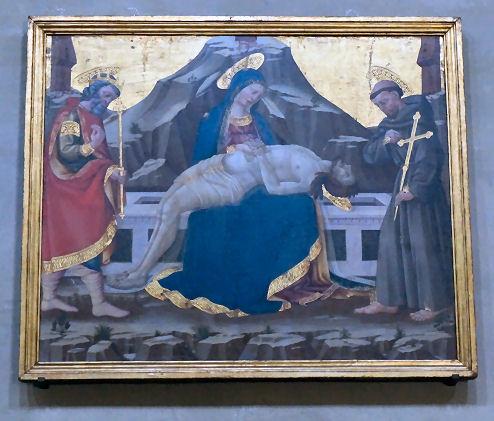 Nothing in the chapels, but there's a rather nice Pietà with Saints over the last confessional on the left, with a very uncomfortable looking Christ (see right), said to be by Neri di Bicci. On the left wall of the apse is a Virgin Enthroned by Giovanni dal Ponte (see below right) with an odd Crucifix on the opposite wall. There are also two altarpiece panels depicting Saints Cosmas and Damian and Saints Francis and Anthony by Rossello di Jacopo Franchi, a pupil of Lorenzo Monaco. A terracotta relief of the Deposition by Giovanni della Robbia is over the north door. Tombs Buried here are Tanai de' Ner  li, the statesman and persecutor of
Savonarola who commissioned the Virgin and Child with Saints (also
known as the Pala de' Nerli) by Filippino Lippi in
Santo Spirito. Also Marcello Virgilio Adriani, who signed Savonarola's death
sentence in 1498 and whose bust by Andrea Ferrucci, who also carved the
Crucifix here, is to be found on the inner façade. li, the statesman and persecutor of
Savonarola who commissioned the Virgin and Child with Saints (also
known as the Pala de' Nerli) by Filippino Lippi in
Santo Spirito. Also Marcello Virgilio Adriani, who signed Savonarola's death
sentence in 1498 and whose bust by Andrea Ferrucci, who also carved the
Crucifix here, is to be found on the inner façade.Lost relics On the high altar the Franciscans kept the habit said to have been the one worn by Saint Francis when he received the stigmata on Mount Verna in 1224. It came here following seizure as booty in1503 from the castle of Monte Acuto during the war against the Aratines. The Franciscans took the relic to Ognissanti with them but it was returned to the sanctuary at La Verna when the Franciscans left Ognissanti on November 1st 2000. Lost art The Annunciation, an altarpiece by Zanobi Strozzi from 1440-45 in the National Gallery, London came from here, having been installed in the 1435 church and later removed during the Napoleonic suppressions in 1810. It is thought to have been in the Lanfredini chapel here as their insignia (the red and white target) is visible on the capitals of the columns in the painting. Vasari reported on the painting being here, when the church was called San Francesco, but said it was by Fra Angelico, who was Strozzi's teacher. The painting is signed among the gilded foliage in the border of the Virgin’s cloak. A carved wooden Crucifix group by the German sculptor 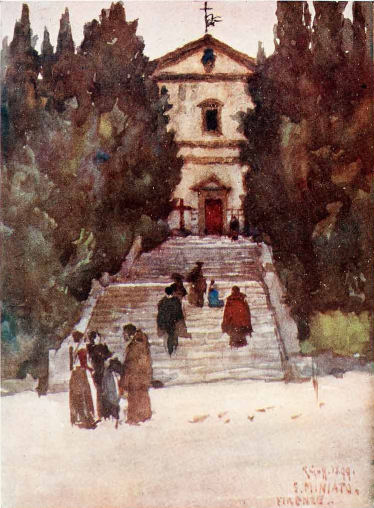 Veit Stoss was commissioned around 1500 by someone
called Santi délia Fonte for this church but was transferred to
Ognissanti in 1561. Veit Stoss was commissioned around 1500 by someone
called Santi délia Fonte for this church but was transferred to
Ognissanti in 1561.The church in art The Tate Gallery in London has two pages from one of Turner's sketchbooks which it labels Two Sketches of a Church in Florence (San Salvatore al Monte?) and that question mark is well earned. There's also a clearer view called Florence from San Miniato al Monte, with San Salvatore al Monte. He drew many panoramas of Florence from up here too. A lovely pen and wash drawing by Giuseppe Zocchi, from the early 1740s, of a panorama of Florence and a side view of San Salvatore is in the Albertina in Vienna. One of 19th century painter Robert Charles Goff's many scenes of Florence and Tuscany features San Salvatore al Monte (see right). He was a follower of Whistler and an Irish Army colonel who travelled much and lived in Florence and Brighton |
|
|
|
San Salvatore di
Camaldoli |
||
|
|
|
|
|
|
||
|
San Sebastiano dei Bini Via Romana |
||
|
|
  |
|
|
Sant’Ilario a Colombaia |
||
  History As early as 1072 there was a reference to a small oratory here built by French and German pilgrims who travelled the Via Cassia on the way to Rome. Around 1300 a church was built here, dedicated to St Hilary, the Bishop of Poitiers in the 4th century. Originally known as Sant'Ilario alle Fonti, due to a fountain in nearby Via Senese. The name Colombaia (dove-cote) may refer to the large number of pigeons that frequented the hillside, or to a nearby villa. The church served a very large parish, stretching from the hill of San Gaggio to Marignolle and Bobolino, and reaching along the outside of the city walls as far as the slopes of Bellosguardo. Amongst the Florentine families who held the patronage of this church, were the Adimari, the Ghiberti, the Donati and the Quaratesi. Damaged during the siege by Castruccio Castracani in 1325, it was rebuilt in 1457 by the rector Girolamo Bindi. There have been many alterations over the course of the centuries, such as the enlargement of the choir and presbytery. The campanile dates from 1880 and was designed by the architects Tanzi and Barchielli. Extensive restructuring, including the reopening of the portico, part of the original church, took place in 1954. The frescoes in the portico were rediscovered during this work. They are in poor condition. There is a Virgin and Child with Saints, from the early 15th century, and a courtly scene by Stefano d'Antonio (also 15th-century). The lunette above the door dates from the late 14th century. The interior An aisle-less nave, with an arch leading into the presbytery. The pietra serena balustrade dates from 1713, as does the ceiling painted of The Glory of Saint Hilary. The Stations of the Cross on the walls in glazed terracotta are 20th century and by Serafino Ceri of the Cantagallo factory. A wooden crucifix said to have been used by a branch of the Bianchi brotherhood which was wiped out nearby by the plague in 1400 is preserved in the attached oratory. |
||
|
Santa Chiara Via dei Serragli |
||
|
|
|
|
|
Santa Elisabetta della
Convertite Via del Campuccio |
||
|
History The Augustinian convent of the Converted Women was so called because it housed nuns who were repentant prostitutes, and perhaps also young women converted from Judaism. Built in 1330 by the Compagnia delle Laudi di Santo Spirito, the convent was enlarged in 1624 by the Grand Duchess Maria Maddalena, mother of Ferdinando II. The house where St Philip Neri was born in 1515 was later attached to it. The convent was suppressed in 1808, and from 1837 has been put to various uses, mostly educational. It was deconsecrated but as there was an orthodox service in progress when I visited in 2012 (see below right) I can only assume that it has been reconsecrated. Interior The deep rear vestibule under the nun's gallery is frescoed with stories of the martyrs by Bernardino Poccetti. There's a painted ceiling by Alessandro Gherardini of the Glory of Saint Mary Magdalene, a small Brunelleschi-like arched square apse and one altar on each side of the nave. Lots of icons. Lost art  Sandro Botticelli's The Trinity with Saints Mary Magdalene, John the Baptist, the Archangel Raphael and Tobias of 1491-94 (see right), the main panel from an altarpiece, now in the Courtauld Gallery in London, was probably painted for the high altar here. It needed a clean and didn't really look much like a Botticelli, suggesting considerable workshop involvement. But a recent 3-year restoration prior to the reopening of the Courtauld galleries in 2021 has seen the altarpiece's darkened varnish removed and it now looks fine. A special exhibition in 2023 will detail the restoration work. During the work it was discovered that Tobias and Raphael (depicted in miniature bottom left) were originally fully painted further away behind the cross and so in more correct proportion to the other figures. These original figures were likely the work of Filippino Lippi, then Botticelli's assistant. The altarpiece was commissioned by the Arte dei Medici e degli Speziali (the Guild of Doctors and Pharmacists) which may explain the presence of Tobias, who found a fish which cured his father’s blindness. The four panels in the predella show scenes from the Life of Mary Magdalen, an appropriate subject for the church of a convent for repentant prostitutes. The scenes are The Conversion of the Magdalen, The Feast in the House of Levi, Noli me Tangere, and The Last Moments of Mary Magdalen, and they are now in the Philadelphia Museum of Art. They were spotted in a dealer's in Florence in 1908 by Herbert Horne, a friend and associate of Roger Fry, who was then employed by the Met in New York. Spurned by the Met trustees they were bought by J.G. Johnson, whose collection later went to the Philadelphia Museum. Soon after Johnson's purchase Bernard Berenson, who'd had a falling out with Fry, told Johnson that he thought that they were not by Botticelli, but by a certain 'Amico di Sandro', an associate of Botticelli of Berenson's invention. He later changed his mind, grudgingly, but only to then say that he now thought them by Botticelli himself, but inferior works. Those guys! Carlo Portelli's Crucifix with the Virgin and Saints is in the Andrea del Sarto Cenacolo Museum at San Salvi. |
|
|
|
Interior
Buried here |
|
|
|
Santa Lucia de' Magnoli |
||
|
History The church was founded next to a pilgrims' ospedale in 1078 by Ugoccione della Pressa, a local miller, and finished by his elder son Màgnolo following the death of Uguccione, and so was later known as 'dei Màgnoli'. Tradition has it that this hospital was where Saint Francis and Saint Dominic met in 1211. Francis is said to have visited the nurses here in that year, commemorated by a tabernacle in via de' Bardi. The hospital was destroyed by the landslide of 1284, from which the church also suffered severe damage, and so was also subsequently known as Santa Lucia delle Rovinate (of the Ruins) this suffix also being applied to other buildings in the area. Around 1246 the church passed to the Cluniac monks of San Miniato al Monte, possibly due to the Magnoli family’s devotion to San Miniato. The Cluniac monks continued here until they were replaced at San Miniato in 1373 by Pope Gregory XI with Olivetan Benedictine monks. In 1421 patronage passed to the Uzzano family, who paid for the decoration of the main chapel, including Domenico Veneziano's high altarpiece (see Lost art below). As part of the dowry of Ginevra Da Uzzano patronage passed to the Capponi family, along with their adjacent palazzo. 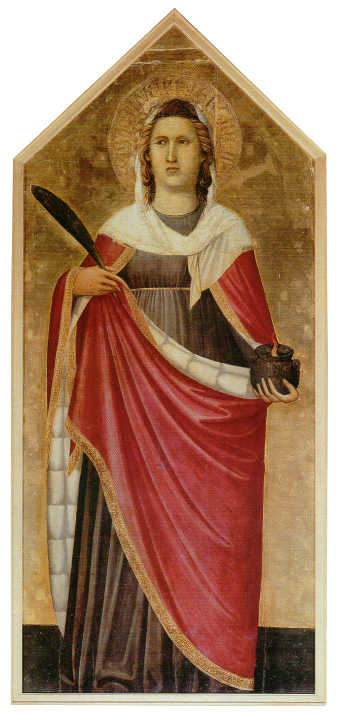 Reconsecrated on May 3rd 1584. The church was rebuilt again in 1732, with an aisle-less nave. Further restorations since then. The lunette over the door is St Lucy Flanked by Two Angels by Benedetto Buglioni, who headed up a rival studio to the della Robbia and probably trained with them. The church is currently used by a Polish congregation. Interior Aisleless with a bare-walled nave with three pietra serena altars each side and a flat frescoed ceiling. The apse is cross-vaulted and more baroquely decorated. The first altar on the left has a much-restored panel painting of Saint Lucy by Pietro Lorenzetti from around 1320 (see right). The sword in the saint's neck, removed during restoration, can still be seen in outline. It was attributed to Giuliano Pesello, a pupil of Andrea del Castagno, until 1905, and its then attribution to Lorenzetti is still not universally accepted. Over the next altar is a Virgin in Glory with Saints by Empoli. The panel depicting The Virgin and Child with Saints John the Baptist, Sylvester, Martin and Filippo Benizzi, on the high altar is by Agnolo di Donino (although the church caption says Florentine School) and was originally in San Giorgio alla Costa up the hill. It replaced the altarpiece by Domenico Veneziano mentioned below. There is a chapel to the right of the entrance, built in 1714-15 in imitation of the Holy House of Loreto (an example of which also exists in the church of San Pantalon in Venice) which contains a wooden Virgin from Loreto. It also houses The Angel of the Annunciation and The Virgin Annunciate by Jacopo del Sellaio (1473).
Lost art
Opening times Bibliography |
|
|
|
Santa Maria a Ricorboli |
||
|
History Ricorboli refers to a small village just outside the city walls of Florence. A hermitage with an oratory and a small hospital was documented in the 12th/13th century on the site of the church, patronized by the Mozzi and Ardinghelli families. The oratory was run by Benedictines in
the late 14th century and after their suppression by Eugene IV by
hermits of Saint Augustine. Beginning in 1478 a church was built, which in
1585 was entrusted to a lay brotherhood, called the Compagnia di Ricorboli.
This company was suppressed, along with all the other brotherhoods, by
Pietro Leopoldo in 1788 , the church passing to parish use. Modern stained glass windows by the
Polloni glassworks, of the Coronation of the Virgin (facade), the Trinity
(apse), Angels, Saints and Evangelists (on the sides). Campanile
|
|
|
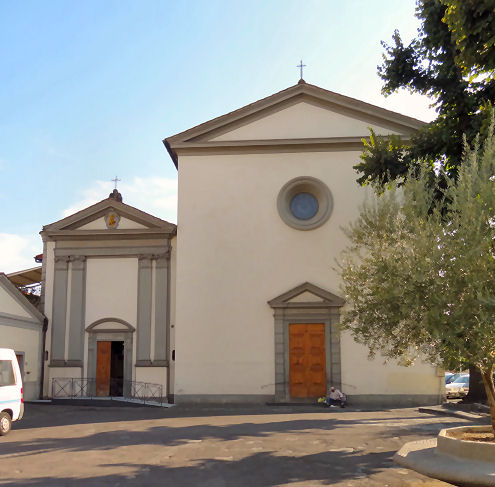 History The church's name comes from the name of the local area, a 'pigna' being an old brick pine cone-shaped structure used to moor boats on wharves once to be found nearby. In 1785 the old parish church was suppressed by the Grand Duke Peter Leopold, and this church was built, to designs by Bernardo Fallani, on land owned by Olivetan monks, chosen by the Grand Duke himself. Consecration followed on the 30th of November 1787. The church was restored in 1931, and again in 1972. Interior |
||
|
Santa Maria del Carmine Piazza del Carmine |
||
|
Santa
Monica Via Santa Monaca |
||
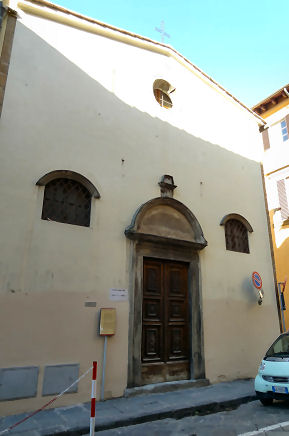 History In April 1441 one Luca di Taddeo was visiting female relatives at the Augustinian convent of Santa Monaca (local dialect for Saint Monica) in the town of San Miniato. Finding the premises unsuitable he suggested to the Abbess, Suor Jacopa di Gomberoni da Milano, that she move her community to more suitable lodgings, offering his help. With the added incentive of locally-raging wars she came to live with Luca in December 1441. A convent was established in May 1442, with funds donated by Ubertino de' Bardi, whose wife Caterina, barren for many years, had conceived after beseeching Abbess Jacopa to pray on her behalf. The Abbess and her nuns moved in in January 1443. In July 1444 some nuns from Pistoia arrived to bolster numbers. Work on the church, replacing an earlier chapel began in May 1447, directed and financed by Jacopo di Leonardo de’ Bardi, the cousin and heir of Ubertino, the previous donor. Patronage also came from the Capponi family whose coat of arms appears on the façade above the 15th century doorway. Work was halted when nearby Carmelite friars objected to the new church being too close to their monastery. On 3rd August 1447, in the middle of the night, the friars actually came and demolished the stone door frame of the church. This dispute dragged on until February 1449, after Jacopo de’ Bardi obtained a papal bull from Nicholas V on 1 August 1448, giving permission to complete construction of the church. Extensive rebuilding followed in the 16th century with a new high altar with a Deposition by Giovanni Maria Butteri (1583) and a nun's choir. The ceiling was frescoed around 1700 with The Gloria di San Martino by Cosimo Ulivelli. The complex was suppressed in 1808 and has been put to various uses since. Opening times Currently the church is used for exhibitions and concerts, and the convent as hostel accommodation. Bibliography Many thanks to Laura Llewellyn for a read of her PhD thesis Art, Community and Religious Women in the Oltrarno, Florence which added much the history of this convent. |
|
|
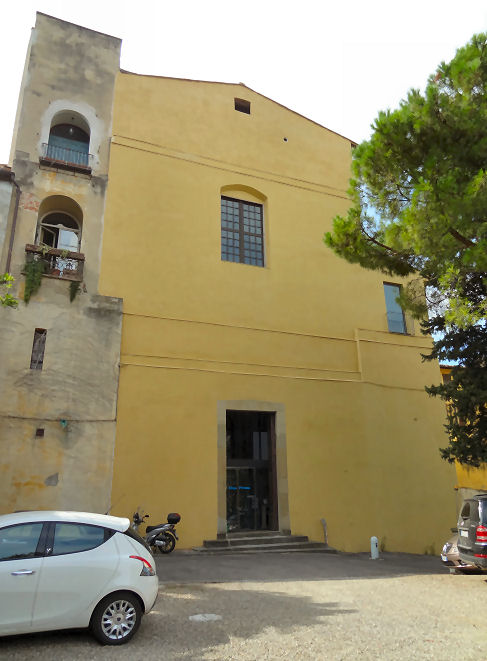
Lost art?
Opening times |
||

The organ, by Pietro Agati, was acquired in 1811 when the nearby monastery of Monte Oliveto was suppressed and its possessions were sold off. It has recently (2009) been restored.
|
||
  History Opened for worship in 1881 in a 15th century palazzo at number 18 (said to have Medici connections and to have once been an early home of Machiavelli's family) to attract Anglo-Catholic tourists. This more high-church congregation split from the Anglicans at Holy Trinity in 1877. The interior was altered by its founder Reverend Charles Tooth, from the Tooth Brothers’ brewery family in Burton upon Trent, whose brother Arthur was also a priest and was one of the founders of the high-church movement in England. This work was done with the help of the English Gothic architect George Frederick Bodley, turning the ground floor into a church with a nave, and two aisles, transept and chancel, about 90 feet long and seating 400. The upper floors were used to house the chaplain and parish assistants. The church soon attracted English-speaking expats. John Roddam Spencer Stanhope's stencilled decoration is more than a bit Pre-Raphaelite, unsurprisingly, given Stanhope's close associations with Edward Burne-Jones and George Frederic Watts. This decoration suffered serious damage during the 1966 flood. The altar reredos painting is thought to be by C. Jeffreys, but Spencer Stanhope probably designed the structural elements. The premises were extended with the purchase of 16 Via Maggio in 1906, allowing the building of a lady chapel (which now houses the organ), a sacristy, a bigger vestibule and extra accommodation upstairs. During WWII St. Mark’s was shut down, but left in the care of Father Frederick Bailey, the chaplain, who was arrested and interned for several months in 1944. On his release, he was allowed to return to England. With the arrival of the Allied troops, the church was reopened and services were held by a military chaplain. Father Bailey featured in Alex Preston’s novel In Love and War. The church currently hosts opera and choral performances. The marble statue in the niche by the main door is The Apotheosis of Saint Mark (2007–8) by the American sculptor Jason Arkles. Photo by Gregory Dowling |
||
|
|
||